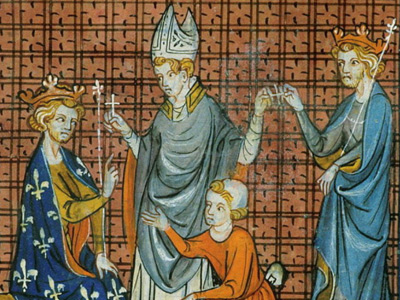Third Crusade (1189–1192)
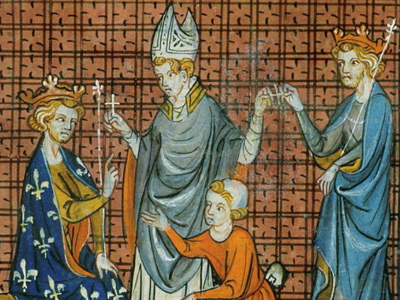
Barbarossa's Crusade
The elderly Holy Roman Emperor Frederick I Barbarossa responded to the call immediately. He took up the Cross at Mainz Cathedral on 27 March 1188 and was the first to set out for the Holy Land in May 1189 with an army of about 100,000 men, including 20,000 knights. An army of 2,000 men led by the Hungarian prince Géza, the younger brother of the king Béla III of Hungary, and Bishop Ugrin Csák also went with Barbarossa to the Holy Land.
The Byzantine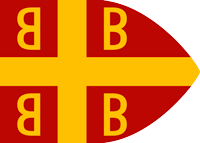 The Byzantine Empire, also referred to as the Eastern Roman Empire or Byzantium, was the continuation of the Roman Empire primarily in its eastern provinces during Late Antiquity and the Middle Ages, when its capital city was Constantinople. It survived the fragmentation and fall of the Western Roman Empire in the 5th century AD and continued to exist for an additional thousand years until the fall of Constantinople to the Ottoman Empire in 1453. Emperor Isaac II Angelos made a secret alliance with Saladin to impede Frederick's progress in exchange for his empire's safety. Meanwhile, the Sultanate of Rum promised Frederick safety through Anatolia, but after much raiding Frederick lost patience and on 18 May 1190, the German army sacked Iconium, the capital of the Sultanate. While crossing the Saleph River on 10 June 1190, Frederick's horse slipped, throwing him against the rocks; he then drowned in the river. After this, much of his army returned to Germany in anticipation of the upcoming Imperial election. The Emperor's son, Frederick of Swabia, led the remaining 5,000 men to Antioch. There, the Emperor's body was boiled to remove the flesh, which was interred in the Church of St. Peter; his bones were put in a bag to continue the crusade. In Antioch, however, the German army was further reduced by fever. Young Frederick had to ask the assistance of his kinsman Conrad of Montferrat to lead him safely to Acre, by way of Tyre, where his father's bones were buried.
The Byzantine Empire, also referred to as the Eastern Roman Empire or Byzantium, was the continuation of the Roman Empire primarily in its eastern provinces during Late Antiquity and the Middle Ages, when its capital city was Constantinople. It survived the fragmentation and fall of the Western Roman Empire in the 5th century AD and continued to exist for an additional thousand years until the fall of Constantinople to the Ottoman Empire in 1453. Emperor Isaac II Angelos made a secret alliance with Saladin to impede Frederick's progress in exchange for his empire's safety. Meanwhile, the Sultanate of Rum promised Frederick safety through Anatolia, but after much raiding Frederick lost patience and on 18 May 1190, the German army sacked Iconium, the capital of the Sultanate. While crossing the Saleph River on 10 June 1190, Frederick's horse slipped, throwing him against the rocks; he then drowned in the river. After this, much of his army returned to Germany in anticipation of the upcoming Imperial election. The Emperor's son, Frederick of Swabia, led the remaining 5,000 men to Antioch. There, the Emperor's body was boiled to remove the flesh, which was interred in the Church of St. Peter; his bones were put in a bag to continue the crusade. In Antioch, however, the German army was further reduced by fever. Young Frederick had to ask the assistance of his kinsman Conrad of Montferrat to lead him safely to Acre, by way of Tyre, where his father's bones were buried.
The early departure of the bulk of the German army after Frederick's death inspired his son, Henry VI, Holy Roman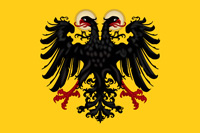 The Holy Roman Empire was a political entity in Western, Central, and Southern Europe that developed during the Early Middle Ages and continued until its dissolution in 1806 during the Napoleonic Wars. From the accession of Otto I in 962 until the twelfth century, the Empire was the most powerful monarchy in Europe. The empire reached the apex of territorial expansion and power in the mid-thirteenth century, but overextending led to partial collapse. Emperor, seven years later to sponsor the German Crusade of 1197.
The Holy Roman Empire was a political entity in Western, Central, and Southern Europe that developed during the Early Middle Ages and continued until its dissolution in 1806 during the Napoleonic Wars. From the accession of Otto I in 962 until the twelfth century, the Empire was the most powerful monarchy in Europe. The empire reached the apex of territorial expansion and power in the mid-thirteenth century, but overextending led to partial collapse. Emperor, seven years later to sponsor the German Crusade of 1197.
HISTORY
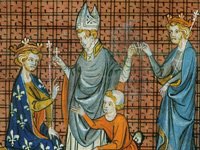
RESOURCES
This article uses material from the Wikipedia article "Third Crusade (1189–1192)", which is released under the Creative Commons Attribution-Share-Alike License 3.0.
© Stories Preschool. All Rights Reserved.
